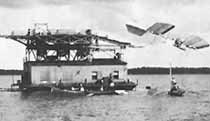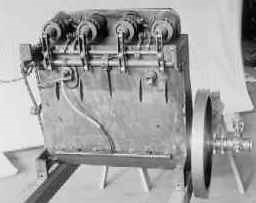prior to their historic flight in 1903, the wright brothers owned what type of business? barber shop

USAF
Since 1899, Wilbur and Orville Wright had been scientifically experimenting with the concepts of flight. They labored in relative obscurity, while the experiments of Samuel Langley of the Smithsonian were followed in the press and underwritten past the War Department. Even so Langley, equally others before him, had failed to achieve powered flight. They relied on brute power to keep their theoretically stable machines aloft, sending forth a hapless rider and hoping for the best. Information technology was the Wrights' genius and vision to see that humans would have to fly their machines, that the issues of flight could not be solved from the ground. In Wilbur'due south words, "It is possible to fly without motors, but not without knowledge and skill." With over a thousand glides from atop Big Kill Devil Loma, the Wrights made themselves the showtime true pilots. These flying skills were a crucial component of their invention. Before they ever attempted powered flying, the Wright brothers were masters of the air.

Library of Congress; Prints and Photographs Sectionalization; LC-W86- 58
Their glider experiments on the Outer Banks of Northward Carolina, though frustrating at times, had led them down the path of discovery. Through those experiments, they had solved the problem of sustained lift and more importantly they could now control an aircraft while in flight. The brothers felt they were now ready to truly fly. But get-go, the Wrights had to power their aircraft. Gasoline engine technology had recently avant-garde to where its utilize in airplanes was viable. Unable to find a suitable lightweight commercial engine, the brothers designed their ain. It was cruder and less powerful than Samuel Langley's, only the Wrights understood that relatively little power was needed with efficient lifting surfaces and propellers. Such propellers were not available, however. Scant relevant data could be derived from marine propeller theory. Using their air tunnel data, they designed the first efficient airplane propeller, one of their virtually original and purely scientific achievements.
Returning to their camp at the Kill Devil Hills, they mounted the engine on the new forty-foot, 605-pound Flyer with double tails and elevators. The engine drove 2 pusher propellers with chains, one crossed to make the props rotate in opposite directions to annul a twisting tendency in flying. A balky engine and broken propeller shaft slowed them, until they were finally ready on Dec 14th. In social club to decide who would fly first, the brother tossed a coin. Wilbur won the coin toss, simply lost his chance to be the first to fly when he oversteered with the elevator subsequently leaving the launching runway. The flyer, climbed too steeply, stalled, and dove into the sand. The first flight would accept to wait on repairs.
December 17, 1903
Three days after, they were ready for the second attempt. The 27-mph air current was harder than they would take liked, since their predicted cruising speed was only 30-35 mph. The headwind would deadening their groundspeed to a clamber, but they proceeded anyway. With a canvas, they signaled the volunteers from the nearby lifesaving station that they were about to endeavour again. Now it was Orville's turn.
Remembering Wilbur'due south experience, he positioned himself and tested the controls. The stick that moved the horizontal lift controlled climb and descent. The cradle that he swung with his hips warped the wings and swung the vertical tails, which in combination turned the machine. A lever controlled the gas flow and airspeed recorder. The controls were simple and few, merely Orville knew information technology would take all his finesse to handle the new and heavier aircraft.

NPS
At 10:35, he released the restraining wire. The flyer moved downwards the rails every bit Wilbur steadied the wings. Just every bit Orville left the ground, John Daniels from the lifesaving station snapped the shutter on a preset camera, capturing the celebrated image of the airborne shipping with Wilbur running aslope. Again, the flyer was unruly, pitching up and down as Orville overcompensated with the controls. But he kept it aloft until information technology striking the sand about 120 feet from the rail. Into the 27-mph current of air, the groundspeed had been 6.eight mph, for a total airspeed of 34 mph. The brothers took turns flying three more times that day, getting a feel for the controls and increasing their altitude with each flying. Wilbur's second flight - the fourth and terminal of the day – was an impressive 852 feet in 59 seconds.
This was the real thing, transcending the powered hops and glides others had achieved. The Wright auto had flown. Merely it would not fly again; after the final flight it was caught by a gust of wind, rolled over, and damaged beyond easy repair. With their flying flavour over, the Wrights sent their father a matter-of-fact telegram reporting the pocket-sized numbers behind their epochal achievement.
devrieswhickeenet.blogspot.com
Source: https://www.nps.gov/wrbr/learn/historyculture/thefirstflight.htm
0 Response to "prior to their historic flight in 1903, the wright brothers owned what type of business? barber shop"
Postar um comentário